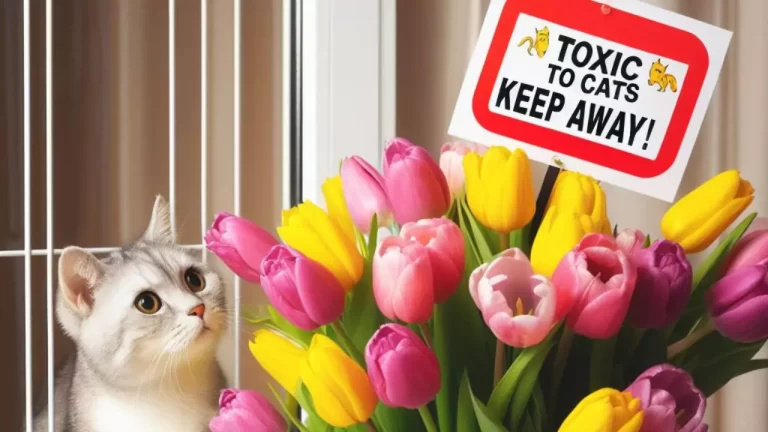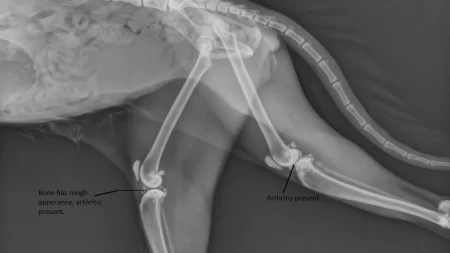Yes, tulips are toxic to cats. If your cat ingests any part of a tulip plant, it can cause serious health problems.
Tulips contain several toxic compounds including alkaloids, glycosides, and allergenic lactones. Hence, Ingesting even small amounts can cause stomach upset, drooling, vomiting, and diarrhea. Larger ingestions can lead to dangerously low blood calcium levels.
Tulip poisoning in cats is a common and potentially life-threatening condition that requires immediate veterinary attention.
In this article, we will explain what tulip poisoning is, what causes it, how it is diagnosed and treated, and how you can keep your cat safe from tulips.
What is Tulip Poisoning in Cats?
Tulip poisoning is a type of plant toxicity that occurs when a cat eats or comes into contact with any part of a tulip plant, such as the flower, stem, leaf, or bulb. Tulips belong to the lily family, which contains many plants that are poisonous to cats.
Tulips contain a group of toxins called Tulipalin, which are allergens that can cause severe irritation and damage to the cat’s mouth, throat, stomach, and liver. Tulip poisoning can also affect the cat’s nervous system and heart.
The symptoms of tulip poisoning in cats can vary depending on the amount and type of tulip ingested, the size and health of the cat, and the time elapsed since exposure. Some common symptoms include:
- Vomiting
- Diarrhea
- Drooling
- Loss of appetite
- Mouth ulcers
- Difficulty swallowing
- Lethargy
- Weakness
- Lack of coordination
- Breathing difficulty
- Abnormal heartbeat
- Seizures
- Coma
Tulip poisoning can be fatal if left untreated. Therefore, it is important to seek veterinary care as soon as possible if you suspect your cat has eaten or been exposed to tulips.
Causes and Diagnosis of Tulip Poisoning in Cats
The main cause of tulip poisoning in cats is ingestion of any part of the tulip plant. Cats may be attracted to the bright colors and fragrant smells of tulips, or they may accidentally ingest them while grooming themselves or playing with them. Cats may also dig up and eat the bulbs of tulips, which are the most toxic part of the plant.
The diagnosis of tulip poisoning in cats is based on the history of exposure, the clinical signs, and the physical examination. The veterinarian may also perform blood tests, urine tests, and imaging tests to assess the extent of the damage and rule out other causes. The veterinarian may also try to identify the type and amount of tulip ingested by examining the vomit or stool of the cat.
Treatment and Recovery of Tulip Poisoning in Cats
The treatment of tulip poisoning in cats depends on the severity of the condition and the time since exposure. The main goals of treatment are to remove the toxin from the cat’s body, prevent further absorption, and provide supportive care.
The veterinarian may induce vomiting or perform gastric lavage (stomach pumping) to remove any remaining tulip material from the cat’s stomach. The veterinarian may also administer activated charcoal to bind to the toxin and prevent it from entering the bloodstream. The veterinarian may also give intravenous fluids to rehydrate the cat and flush out the toxin from the kidneys. The veterinarian may also give medications to control vomiting, diarrhea, pain, inflammation, seizures, and heart problems.
The recovery of tulip poisoning in cats depends on several factors, such as the amount and type of tulip ingested, the speed and quality of treatment, and the overall health of the cat. Some cats may recover within a few hours or days with proper treatment, while others may suffer from long-term complications or even die. The veterinarian will monitor the cat’s vital signs, blood tests, urine tests, and organ function during and after treatment. The veterinarian will also advise on how to care for the cat at home and when to follow up.
Keep Your Cat Safe from Tulips
The best way to prevent tulip poisoning in cats is to avoid having tulips in your home or garden if you have a cat. If you do have tulips or receive them as a gift, make sure they are out of reach of your cat. You can also spray them with a bitter or unpleasant substance to deter your cat from chewing on them. You can also cover or fence off any areas where you have planted tulip bulbs to prevent your cat from digging them up.
If you want to have flowers that are safe for your cat, you can choose from many alternatives that are non-toxic or even beneficial for your feline friend. Some examples are:
- African violet
- Aster
- Bamboo
- Basil
- Cilantro
- Dill
- Freesia
- Gerber daisy
- Lemon balm
- Orchid
- Rose
- Sunflower
You can also grow some plants that are specifically meant for your cat to enjoy, such as:
- Catnip
- Cat grass
- Catmint
- Valerian
By choosing cat-friendly plants, you can create a beautiful and healthy environment for your cat and yourself.







